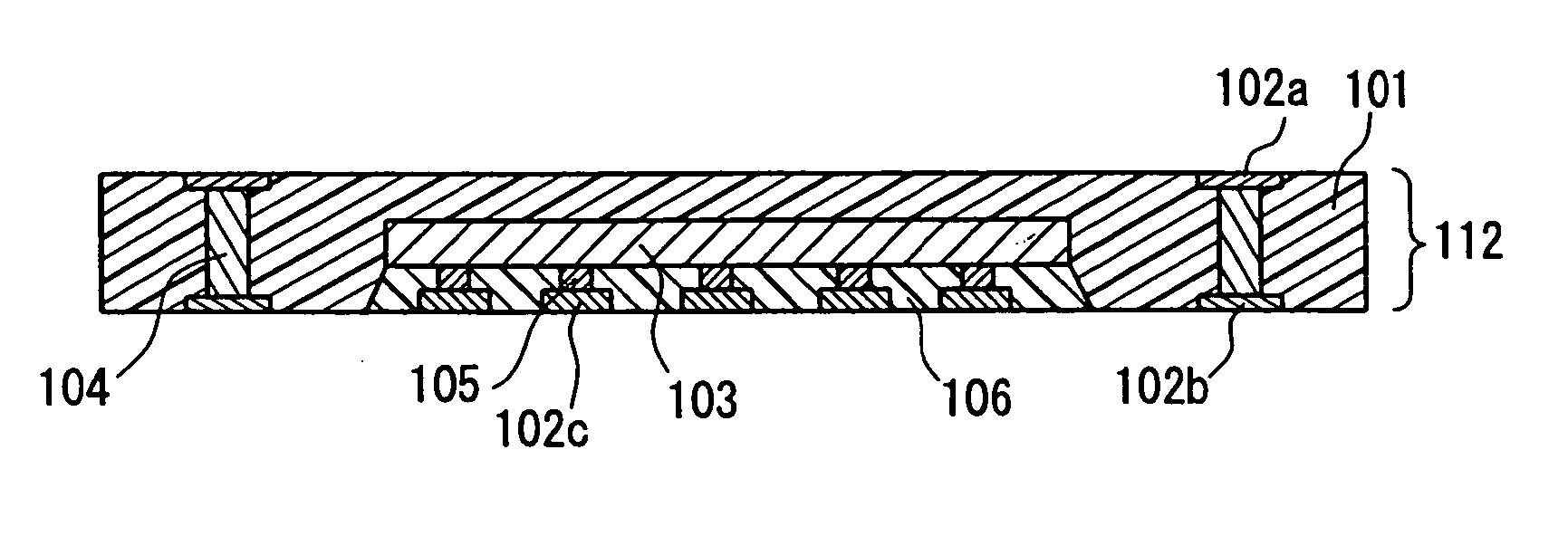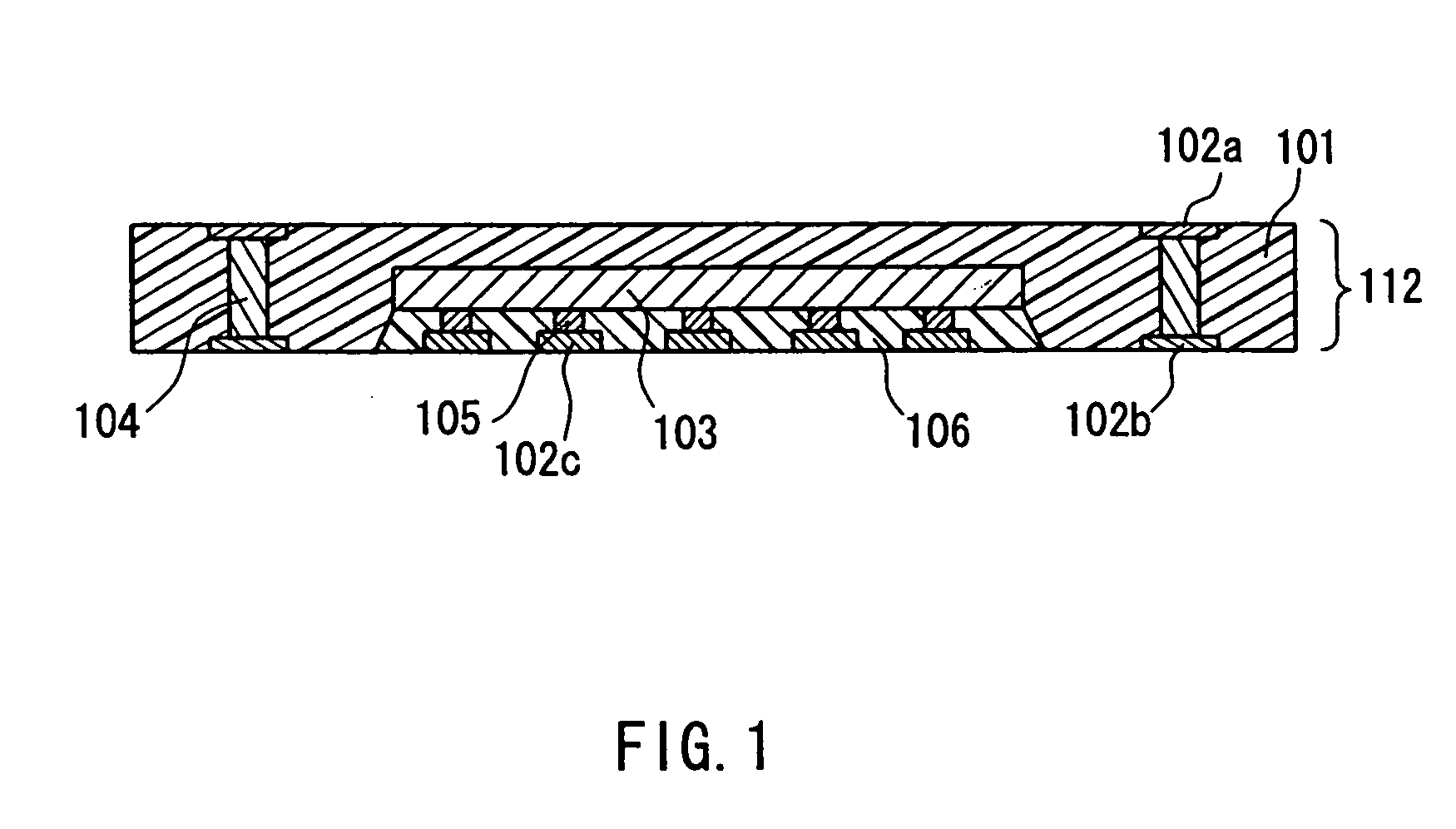Circuit component built-in module with embedded semiconductor chip and method of manufacturing
a semiconductor chip and built-in module technology, applied in the association of printed circuit non-printed electric components, basic electric elements, solid-state devices, etc., can solve the problems of reducing manufacturing yield, reducing manufacturing yield, and high cost of substrate recess formation process
- Summary
- Abstract
- Description
- Claims
- Application Information
AI Technical Summary
Benefits of technology
Problems solved by technology
Method used
Image
Examples
embodiment 2
[0071] FIG. 3A illustrates a cross section of a circuit component built-in module 312 according to the present embodiment. The circuit component built-in module 312 is configured so that a semiconductor chip 303 in a wafer-level chip-scale package (wafer-level CSP) form having a sufficiently small chip thickness is incorporated in an electrical insulating substrate 301. A multilayer substrate 303a is integrated and incorporated additionally. 302a denotes a wiring pattern formed on a principal surface of the electrical insulating substrate 301, and 302b denotes a wiring pattern formed on the other principal surface of the electrical insulating substrate 301. Wiring patterns 302a and 302b are connected electrically with each other through inner vias 304 that pass through the electrical insulating substrate 301.
[0072] FIG. 3B illustrates an example of a configuration in which a wafer-level CSP 303a is mounted on a multilayer substrate 306 for rewiring. A circuit component built-in modu...
embodiment 3
[0081] FIG. 5 illustrates a cross section of a circuit component built-in module 512 according to the present embodiment. Members thereof corresponding to the circuit component built-in module 112 according to Embodiment 1 are made of the same materials processed in the same manners. The circuit component built-in module 512 is configured so that semiconductor chips 503a and 503b are incorporated in an electrical insulating substrate 501 in a state in which upper surfaces of the semiconductor chips 503a and 503b face each other. 502b and 502c denote wiring patterns formed on a principal surface of the electrical insulating substrate 301, and 502a and 502d denote wiring patterns formed on the other principal surface of the electrical insulating substrate 501. The wiring patterns 502a and 502b are connected electrically with each other through inner vias 504 that pass through the electrical insulating substrate 501. The semiconductor chips 503a and 503b are connected electrically with...
embodiment 4
[0090] FIG. 7B illustrates a cross section of a stacked module 712 according to the present embodiment. The stacked module 712 is configured so that circuit component built-in modules 112, each of which is according to Embodiment 1, are stacked.
[0091] The following describes an example of a method for manufacturing the stacked module 712 according to the present embodiment, while referring to FIGS. 7A and 7B.
[0092] First of all, circuit component built-in modules 701a to 701d are produced (FIG. 7A) in the same manner as that in Embodiment 1 except for that the heating temperature is set to be in a range of 100.degree. C. to 130.degree. C. so that a mixture of a composite sheet 701 and a conductive resin composition in through holes 704 is maintained in a semi-cured or partially cured state (B-stage state).
[0093] Next, the circuit component built-in modules are stacked under a controlled pressure, so as to form a four-layer stacked module 712 (FIG. 7B). In FIGS. 7A and 7B, 702a and 7...
PUM
 Login to View More
Login to View More Abstract
Description
Claims
Application Information
 Login to View More
Login to View More - R&D
- Intellectual Property
- Life Sciences
- Materials
- Tech Scout
- Unparalleled Data Quality
- Higher Quality Content
- 60% Fewer Hallucinations
Browse by: Latest US Patents, China's latest patents, Technical Efficacy Thesaurus, Application Domain, Technology Topic, Popular Technical Reports.
© 2025 PatSnap. All rights reserved.Legal|Privacy policy|Modern Slavery Act Transparency Statement|Sitemap|About US| Contact US: help@patsnap.com



